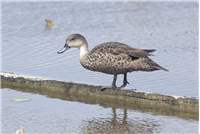Family
Anatidae
Genus
Anas
Species
gracilis
Threats/Control Methods - Regional
This waterbird is susceptible to population declines in response to prolonged drought, as they will not breed unless the conditions are favourable. They are at risk of attack from various predators, especially as they are forced to nest on the ground due to a decline of available tree hollows. They are also Australia's second most popular game bird and are hunted where it is legal.
Threats/Control Methods - Local
Water bodies in urban areas are less resilient against periods of droughts or extreme weather events, causing a build-up of toxins and dangerous algae levels, which may impact the health of this species. Free-roaming domestic pets are likely to disturb nest sites and hunt young ducks.
Local/Urban Actions
Residents living near water bodies can provide a safe breeding site by installing a vertical nest box at any height from the ground, with an entrance diameter of 16cm and an inside diameter of 35cm. Dogs should be kept on a lead around urban waterbodies and cat owners can install a cat run or enclosure. Local waterways will be kept clean if everyone avoids letting chemicals, pet faeces or garden waste going down the stormwater drain. Keep gutters clean and call the Canberra Connect helpline on (02) 6207 9777 for specific chemical waste disposal information.
Common Names
Grey Teal, Slender Teal, Wood Teal
Distinguishing Features
This medium sized, 42-45cm duck has a patchy appearance, as each grey-brown feather is edged in a cream colour. It has a red eye and a pale patch on the throat, just below the grey bill. When wings are spread, a thick, green-black band of feathers and a large white wing patch are noticeable. From underneath, wing feathers are mostly grey-brown, edged with a dark band. Young birds are slightly paler.
Survey Techniques
Call and visual identification.
Species Call
The female makes a loud, continuous quacking. Males make an almost muted 'pip!'.
Similar Species
It is difficult to distinguish between this species and female Chestnut Teals (Anas castanea), with the light colour of the Grey Teal's throat being the major difference.
Distribution
This species is found in all areas of Australia, travelling to areas after heavy rainfall events. They are also widespread across many of Australia's neighbouring islands in the Pacific and on and around New Zealand and TAS.
Country of Origin
Australia
Conservation (Pet/Pest) Status - Regional
This species is uncommon in the ACT region.
Conservation (Pet/Pest) Status - National
Secure, not listed under the EPBC Act 1999. It is considered one of the most numerous and widespread of all the Australian ducks.
LSCCES Population
Three sightings were made on the ANU campus.
Associated vegetation community
This species will inhabit almost any wetland environment, moving to more favourable habitats following rain events, preferring swamps, lagoons and inland floodwaters.
Limiting Resources
The Grey Teal can only survive in areas with abundant water, prefering wetlands with plenty of aquatic vegetation and mature, hollow-bearing trees for nesting. However, it is a frequent traveller and will confidently move to more optimal locations.
Breeding
The main breeding period usually runs from July to November, however the Grey Teal will respond to breed after a significant rainfall event, especially in areas where good rain may not be reliable. In years with good rains, up to three broods can be raised. A hollow limb is the preferred nesting site, but they often nest on the ground, on a simple nest of down feathers. The female carries out all of the nesting activities, laying 6-12 small eggs. She incubates them for 24-26 days and leads the young out of the nest soon after hatching. While many eggs are laid, young birds have an extremely high mortality rate, few surviving past three years.
Behaviour
This species is highly social, spending most of their time in flocks of tens to hundreds. It is often seen in shallow water, bobbing and 'duck diving' down for food, or perched on dead tree branches on the water. They travel in compact flocks with swift flight.
Functional Group
Food Species
The Grey Teal feeds mostly on the seeds of a wide range of aquatic plants, including smartweeds (Polygonum), water-couch (Paspalum), sedges (Carex), rye-grass (Lolium), wallaby-grass (Danthonia) and oat-grass (Agrostis). They will also eat aquatic insects and their larvae, especially water-beetles (Dytiscidae), water-boatmen (Corixidae), midges (Chironomidae) and mosquitoes (Culicidae).
Predators
The low-lying nests of the Grey Teal are easily predated by ground dwelling Black Rats (Rattus Rattus), Silver Gulls (Larus novaehollandiae ) and Swamp Harriers (Circus aeruginosus). The Purple Moorhen (Porphyrio porphyrio ) will steal eggs and may kill ducklings. European Red Foxes (Vulpes vulpes), Dogs (Canis familiaris) and Cats (Felis catus) are also able to attack young birds.
Interesting Fact
The Grey Teal has adapted extremely well to Australia's droughts and floods, somehow seeming to sense distant rainfall, travelling great distances to arrive at areas just days after a significant rainfall event.
References - (reader suitability of references, P=Primary teachers, S=Secondary students, T=Tertiary students and researchers)
Books:Morcombe, M. 2000. Field Guide to Australian Birds. Steve Parish Publishing. Archerfield. Australia P, S, T
Pringle, J. 1985. The Waterbirds of Australia. Angus and Robertson/National Photographic Index of Australian Wildlife, Sydney. S, T
Internet: Birds in Backyards. 2006. [online]. Available at:http://www.birdsinbackyards.net P, S, T
Online Publications:ACT Government. 2006. Information Sheet: Stormwater Pollution from Residential Areas. Environment ACT. [online]. Available at: http://www.environment.act.gov.au/__data/assets/pdf_file/13168/Stormwater_Pollution_from_Residential_Areas.pdf P, S, T
Nix, H. and Cunningham, R. 2006. Birds of the Lower Sullivans Creek Catchment, Canberra ACT. Prepared for the Life in the Suburbs project using data from the Lower Sullivans Creek Catchment Ecological Survey (LSCCES). Australian National University. Canberra. [online]. Available at: http://www.lifeinthesuburbs.com.au/category.php?id=65 S, T

 Top
Top Top
Top